Brake Fluid
The Suzuki Katana uses DOT 4 brake fluid that should be inspected after 600 mi or 1000 km of use. It should be flushed and bled every two years, whenever the brakes feel spongy, or if the brake system has been taken apart and rebuilt. The brake hoses should be replaced every four years.
Always use fresh brake fluid from a new tightly sealed container.
SAFETY FIRST: Protective gloves and eyewear are recommended at this point.
Warning: Brake fluid is very caustic and can damage paint, chrome and plastic. Wipe up any spills immediately.
Inspection

Turn the handlebars until the top of the front master cylinder reservoir is level with the ground. Check the level of brake fluid. The brake fluid should be above the lower line.
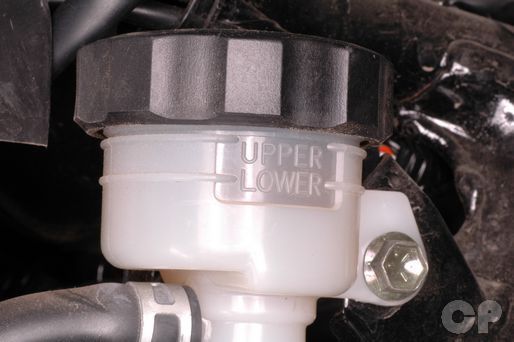
For the rear, make sure the bike is on level ground and sitting perfectly upright. Check the level of brake fluid.
Bleeding
Front
Remove the two front master cylinder cover screws using a #2 Phillips head screwdriver.

Remove the reservoir cap, plastic piece, and rubber diaphragm. Clean and inspect the rubber diaphragm for tears or other damage. Replace as necessary.
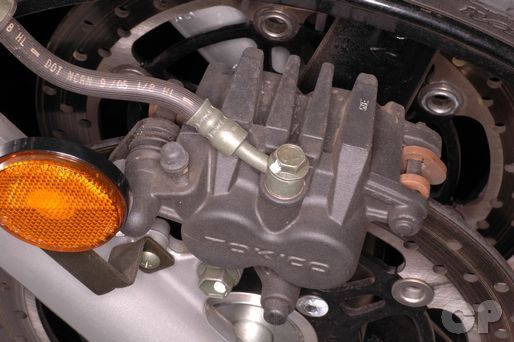
Pull off the rubber cap over the bleeder valve and crack open the bleeder valve on the brake caliper using an 8 mm wrench. This valve is usually very tight so use a box end wrench or a 6 point socket and ratchet to prevent rounding off the head. Snug the bleeder valve back down.
Remove the old brake fluid with a Mighty -Vac or a similar device.
Place a length of 6 mm inside diameter clear hose on the bleeder valve and place the other end in a container.
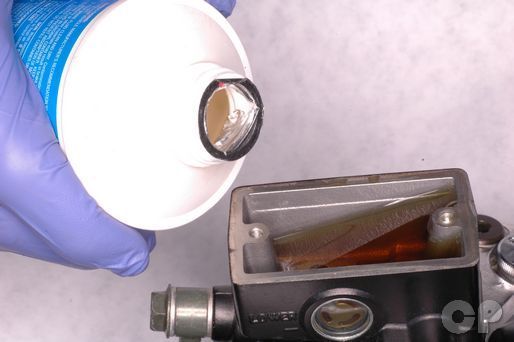
Add DOT 4 brake fluid until it is above the LOWER line but there is still an air bubble visible at the top of the window.

Place the diaphragm, plastic piece, and reservoir cap onto the master cylinder to keep debris out and keep the brake fluid in.
Pump the front brake lever several times and hold the lever in. While holding the lever in, crack open the bleeder valve. The front brake lever will travel all the way to the throttle grip and brake fluid and/or air will come out of the bleeder valve into the 6 mm hose. Tighten the bleeder valve before releasing the front brake lever. Pump the lever several times again and repeat the process. Be certain to check the master cylinder reservoir occasionally to make sure the reservoir doesn't run dry. Add more brake fluid as necessary. Continue this process until clean brake fluid comes out of the bleeder valve and there are no air bubbles. The front brake lever should feel firm.
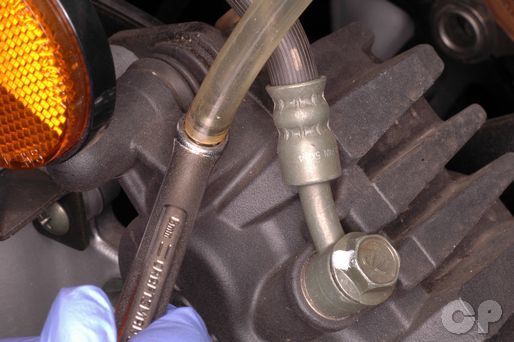
Torque the bleeder valve to specification.
(Specification for brake caliper bleeder valve torque is 8 N-m or 6.0 lb-ft)

If you have bled the air bubbles out of both caliper bleeder valves and the brakes still feel spongy you can use the banjo bolt at the master cylinder as a bleeder valve for the other end of the system. Loosen the master cylinder banjo bolt with a 12 mm socket. Torque the banjo bolt to specification when you have finished bleeding the brakes.
(Master Cylinder Banjo Bolt Torque: 23 N-m or 16.5 lb-ft)

Make sure the brake fluid level is correct. Install the diaphragm, plastic piece, and reservoir cap onto the master cylinder.
Insert the master cylinder reservoir screws and tighten them securely with a #2 Phillips screwdriver.
Rear
Remove the master cylinder reservoir cap, plastic piece, and rubber diaphragm.

Loosen the reservoir mounting bolt with a 10 mm socket. Remove the mounting bolt and free the reservoir from the frame.
Empty the reservoir into a suitable container.
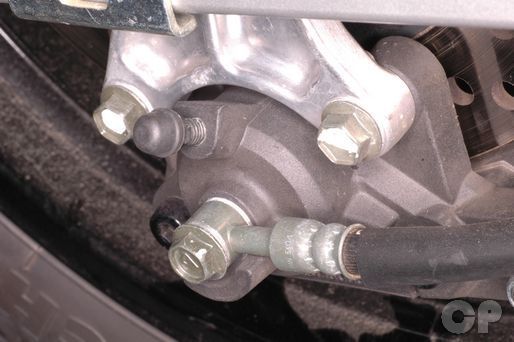
Pull off the rubber cap over the bleeder valve and crack open the bleeder valve on the brake caliper using an 8 mm wrench. This valve is usually very tight so use a box end wrench or a 6 point socket and ratchet to prevent rounding off the head. Snug the bleeder valve back down.
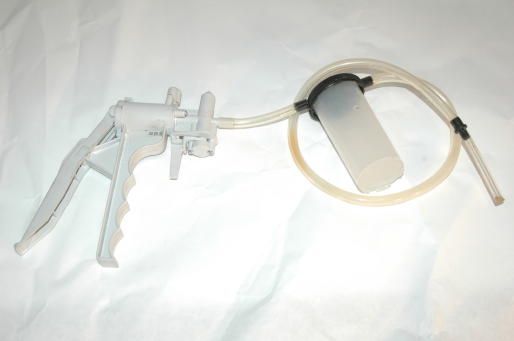
Remove as much of the old brake fluid with a Mighty -Vac or a similar device.

Place a length of 6 mm inside diameter clear hose on the bleeder valve and place the other end in a container.
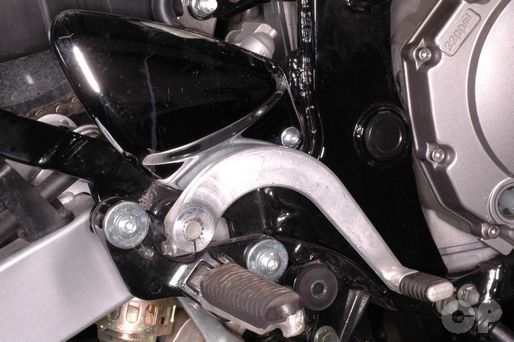
Pump the rear brake pedal several times and then hold it down. While holding the pedal down, crack open the bleeder valve. The pedal will travel all the way down and brake fluid and/or air will come out of the bleeder valve into the 6 mm hose. Tighten the bleeder valve before releasing the pedal. Pump the pedal several times again and repeat the process. Be certain to check the master cylinder reservoir occasionally to make sure the reservoir doesn't run dry. Add more brake fluid as necessary. Continue this process until clean brake fluid comes out of the bleeder valve and there are no air bubbles. The brake pedal should feel firm.
Copyright - Cyclepedia Press LLC

Note: If you are viewing this document offline be sure to visit the latest version online at http://www.cyclepedia.com before attempting any repairs. Updates are made without notice.




















